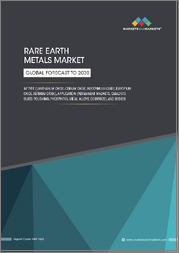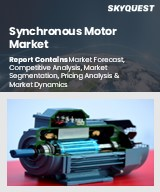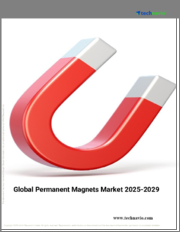
|
시장보고서
상품코드
1623830
영구자석 시장 : 시장 규모, 점유율, 성장 분석 - 유형별, 최종 용도 산업별, 지역별 - 산업 예측(2025-2032년)Permanent Magnet Market Size, Share, Growth Analysis, By Type (Samarium Cobalt magnet, Ferrite magnet), By End-Use Industries (Consumer Electronics, Automotive), By Region - Industry Forecast 2025-2032 |
||||||
영구자석 시장 규모는 2023년 381억 9,000만 달러로 평가되었고, 예측기간 2025년부터 2032년까지의 CAGR은 8.5%로 전망되며, 2024년 414억 4,000만 달러에서 2032년에는 795억 8,000만 달러로 성장할 전망입니다.
영구자석은 외부자화력 없이 자기특성을 유지하는 능력을 특징으로 하며, 다양한 산업에서 중요한 역할을 하고 있습니다. 이 안정된 자석은 흔히 경질자석이라고 불리며 높은 자기 모멘트와 낮은 투자율을 자랑하며 전기 에너지를 기계 에너지로 변환하거나 반대로 기계 에너지를 전기 에너지로 변환하기 위해 필수적입니다. 합금 자석, 페라이트 자석, 본드 자석 등 그 용도는 모터, 스피커, 가전제품, HVAC 시스템 등 다방면에 걸쳐 있습니다. 에너지 효율이 뛰어난 솔루션에 대한 수요가 높아짐에 따라 영구자석은 점점 기술의 진보에 필수적인 것이 되어 다양한 분야에서 성능과 신뢰성을 높이고 있습니다. 이러한 영구자석에 대한 지속적인 의존은 소비자 시장과 산업용 용도 모두에서 영구자석의 중요성을 부각시키며, 이 틈새 분야의 지속적인 성장을 확실하게 하고 있습니다.
목차
서문
- 조사의 목적
- 조사 범위
- 정의
조사 방법
- 정보 조달
- 2차 데이터 및 1차 데이터의 방법
- 시장 규모 예측
- 시장의 전제조건 및 제한
주요 요약
- 세계 시장 전망
- 공급과 수요 동향 분석
- 부문별 기회 분석
시장 역학 및 전망
- 시장 개요
- 시장 규모
- 시장 역학
- 성장 촉진요인 및 기회
- 억제요인 및 과제
- Porter's Five Forces 분석과 영향
- 경쟁 기업간 경쟁 관계
- 대체품의 위협
- 구매자의 협상력
- 신규 참가업체의 위협
- 공급기업의 협상력
주요 시장 인사이트
- 중요성공요인
- 경쟁도
- 주요 투자 기회
- 시장 생태계
- 시장의 매력 지수(2024년)
- PESTEL 분석
- 거시경제지표
- 밸류체인 분석
- 가격 분석
- 기술의 진보
- 규제 상황
- 사례 연구
- 고객과 구매 기준 분석
- 무역 분석
- 스타트업 분석
- 원재료 분석
영구자석 시장 규모 : 유형별
- 시장 개요
- 네오디뮴 철 붕소 자석
- 페라이트 자석
- 사마륨 코발트 자석
- 아르니코 자석
- 기타
영구자석 시장 규모 : 최종 용도 산업별
- 시장 개요
- 가전
- 일반산업
- 자동차
- 의료기술
- 환경 및 에너지
- 항공우주 및 방위
- 기타 최종 이용 산업
영구자석 시장 규모
- 북미
- 미국
- 캐나다
- 유럽
- 영국
- 독일
- 스페인
- 프랑스
- 이탈리아
- 기타 유럽
- 아시아태평양
- 중국
- 인도
- 일본
- 한국
- 기타 아시아태평양
- 라틴아메리카
- 브라질
- 기타 라틴아메리카
- 중동 및 아프리카
- GCC 국가
- 남아프리카
- 기타 중동 및 아프리카
경쟁 정보
- 상위 5개사 비교
- 주요 기업의 시장 포지셔닝(2024년)
- 주요 시장 기업이 채용한 전략
- 시장의 최근 동향
- 기업의 시장 점유율 분석(2024년)
- 주요 기업의 기업 프로파일
- 기업 개요
- 제품 포트폴리오 분석
- 부문별 점유율 분석
- 수익의 전년 대비 비교(2022-2024년)
주요 기업 프로파일
- Hitachi Metals, Ltd.
- TDK Corporation
- Arnold Magnetic Technologies
- Adams Magnetic Products Co., Inc.
- Shin-Etsu Chemical Co., Ltd.
- Daido Steel Co., Ltd.
- Electron Energy Corporation
- Hangzhou Permanent Magnet Group
- Ningbo Yunsheng Co., Ltd.
- Anhui Earth-Panda Advance Magnetic Material Co., Ltd.
- Molycorp Magnequench
- Alpha Magnet
- Tengam Engineering, Inc.
- Bunting Magnetics Co.
- Tridus Magnetics and Assemblies
- Integrated Magnetics
- Lynas Corporation Ltd.
- Magnequench International, LLC
- GKN Powder Metallurgy
- Solvay
결론 및 권장사항
AJY 25.01.16Permanent Magnet Market size was valued at USD 38.19 Billion in 2023 and is poised to grow from USD 41.44 Billion in 2024 to USD 79.58 Billion by 2032, growing at a CAGR of 8.5% during the forecast period (2025-2032).
Permanent magnets, characterized by their ability to retain magnetic properties without an external magnetizing force, play a crucial role in various industries. These stable magnets, often referred to as hard magnets, boast high magnetic moments and low permeability, making them essential for converting electrical energy into mechanical energy and vice versa. With a diverse range of types, including alloy, ferrite, and bonded magnets, their applications span motors, loudspeakers, household appliances, and HVAC systems. As demand for energy-efficient solutions rises, permanent magnets are increasingly integral to technological advancements, enhancing performance and reliability across multiple sectors. This ongoing reliance on permanent magnets highlights their significance in both consumer markets and industrial applications, ensuring sustained growth in this niche segment.
Top-down and bottom-up approaches were used to estimate and validate the size of the Permanent Magnet market and to estimate the size of various other dependent submarkets. The research methodology used to estimate the market size includes the following details: The key players in the market were identified through secondary research, and their market shares in the respective regions were determined through primary and secondary research. This entire procedure includes the study of the annual and financial reports of the top market players and extensive interviews for key insights from industry leaders such as CEOs, VPs, directors, and marketing executives. All percentage shares split, and breakdowns were determined using secondary sources and verified through Primary sources. All possible parameters that affect the markets covered in this research study have been accounted for, viewed in extensive detail, verified through primary research, and analyzed to get the final quantitative and qualitative data.
Permanent Magnet Market Segmental Analysis
Global Permanent Magnet Market is segmented by Type, End-Use Industries and region. Based on Type, the market is segmented into. Based on End-Use Industries, the market is segmented into automotive, consumer electronics, healthcare, agriculture, manufacturing, and others. Based on region, the market is segmented into North America, Europe, Asia Pacific, Latin America and Middle East & and Africa.
Driver of the Permanent Magnet Market
The permanent magnet market is significantly driven by the growing demand for consumer electronics. As the popularity of devices like laptops, televisions, music systems, computers, and smartphones continues to surge, the need for permanent magnets increases correspondingly. These magnets are essential due to their unique properties such as attraction, repulsion, and efficient energy conversion, making them integral components in a wide array of consumer gadgets. The evolution of consumer preferences and ongoing technological advancements further bolster this demand, suggesting a robust market expansion throughout the forecast period as manufacturers respond to the escalating appetite for innovative electronic products.
Restraints in the Permanent Magnet Market
The Permanent Magnet market faces significant restraints primarily due to the volatility in raw material prices. The costs and quality of magnets are heavily influenced by the availability of alloys derived from rare-earth elements, alongside the rising energy expenses. Supply chain disruptions further compound these issues, making it challenging for manufacturers to deliver high-quality products at competitive rates. As a result, these factors are likely to hinder market growth in the foreseeable future, as companies struggle to navigate the unpredictable landscape of raw material procurement and maintain pricing strategies that meet market demands.
Market Trends of the Permanent Magnet Market
The Permanent Magnet market is poised for significant growth, driven primarily by the surging demand for hybrid electric vehicles (HEVs). With HEVs requiring 2 to 3 kg of rare earth magnets for their internal combustion engines and electric motors, the automotive sector's evolution towards sustainability is directly impacting magnet consumption. Furthermore, the application of permanent magnets extends beyond vehicles, finding utility in various components like speakers, electric window regulators, door locks, and windshield wipers. As the automotive industry embraces electrification trends, the heightened demand for magnets will likely catalyze market expansion and innovation across related sectors, positioning permanent magnets as vital to future advancements.
Table of Contents
Introduction
- Objectives of the Study
- Scope of the Report
- Definitions
Research Methodology
- Information Procurement
- Secondary & Primary Data Methods
- Market Size Estimation
- Market Assumptions & Limitations
Executive Summary
- Global Market Outlook
- Supply & Demand Trend Analysis
- Segmental Opportunity Analysis
Market Dynamics & Outlook
- Market Overview
- Market Size
- Market Dynamics
- Driver & Opportunities
- Restraints & Challenges
- Porters Analysis & Impact
- Competitive rivalry
- Threat of substitute
- Bargaining power of buyers
- Threat of new entrants
- Bargaining power of suppliers
Key Market Insights
- Key Success Factors
- Degree of Competition
- Top Investment Pockets
- Market Ecosystem
- Market Attractiveness Index, 2024
- PESTEL Analysis
- Macro-Economic Indicators
- Value Chain Analysis
- Pricing Analysis
- Technological Advancement
- Regulatory Landscape
- Case Studies
- Customer & Buying Criteria Analysis
- Trade Analysis
- Startup Analysis
- Raw Material Analysis
Global Permanent Magnet Market Size by Type & CAGR (2024-2032)
- Market Overview
- Neodymium Iron Boron Magnets
- Ferrite Magnets
- Samarium Cobalt Magnets
- AlNiCo Magnets
- Others
Global Permanent Magnet Market Size by End-Use Industries & CAGR (2024-2032)
- Market Overview
- Consumer Electronics
- General Industrial
- Automotive
- Medical technology
- Environment & Energy
- Aerospace & Defense
- Other end-use industries
Global Permanent Magnet Market Size & CAGR (2024-2032)
- North America, (Type, End-Use Industries)
- US
- Canada
- Europe, (Type, End-Use Industries)
- UK
- Germany
- Spain
- France
- Italy
- Rest of Europe
- Asia-Pacific, (Type, End-Use Industries)
- China
- India
- Japan
- South Korea
- Rest of Asia Pacific
- Latin America, (Type, End-Use Industries)
- Brazil
- Rest of Latin America
- Middle East & Africa, (Type, End-Use Industries)
- GCC Countries
- South Africa
- Rest of Middle East & Africa
Competitive Intelligence
- Top 5 Player Comparison
- Market Positioning of Key Players, 2024
- Strategies Adopted by Key Market Players
- Recent Developments in the Market
- Company Market Share Analysis, 2024
- Company Profiles of All Key Players
- Company Details
- Product Portfolio Analysis
- Company's Segmental Share Analysis
- Revenue Y-O-Y Comparison (2022-2024)
Key Company Profiles
- Hitachi Metals, Ltd.
- Company Overview
- Business Segment Overview
- Financial Updates
- Key Developments
- TDK Corporation
- Company Overview
- Business Segment Overview
- Financial Updates
- Key Developments
- Arnold Magnetic Technologies
- Company Overview
- Business Segment Overview
- Financial Updates
- Key Developments
- Adams Magnetic Products Co., Inc.
- Company Overview
- Business Segment Overview
- Financial Updates
- Key Developments
- Shin-Etsu Chemical Co., Ltd.
- Company Overview
- Business Segment Overview
- Financial Updates
- Key Developments
- Daido Steel Co., Ltd.
- Company Overview
- Business Segment Overview
- Financial Updates
- Key Developments
- Electron Energy Corporation
- Company Overview
- Business Segment Overview
- Financial Updates
- Key Developments
- Hangzhou Permanent Magnet Group
- Company Overview
- Business Segment Overview
- Financial Updates
- Key Developments
- Ningbo Yunsheng Co., Ltd.
- Company Overview
- Business Segment Overview
- Financial Updates
- Key Developments
- Anhui Earth-Panda Advance Magnetic Material Co., Ltd.
- Company Overview
- Business Segment Overview
- Financial Updates
- Key Developments
- Molycorp Magnequench
- Company Overview
- Business Segment Overview
- Financial Updates
- Key Developments
- Alpha Magnet
- Company Overview
- Business Segment Overview
- Financial Updates
- Key Developments
- Tengam Engineering, Inc.
- Company Overview
- Business Segment Overview
- Financial Updates
- Key Developments
- Bunting Magnetics Co.
- Company Overview
- Business Segment Overview
- Financial Updates
- Key Developments
- Tridus Magnetics and Assemblies
- Company Overview
- Business Segment Overview
- Financial Updates
- Key Developments
- Integrated Magnetics
- Company Overview
- Business Segment Overview
- Financial Updates
- Key Developments
- Lynas Corporation Ltd.
- Company Overview
- Business Segment Overview
- Financial Updates
- Key Developments
- Magnequench International, LLC
- Company Overview
- Business Segment Overview
- Financial Updates
- Key Developments
- GKN Powder Metallurgy
- Company Overview
- Business Segment Overview
- Financial Updates
- Key Developments
- Solvay
- Company Overview
- Business Segment Overview
- Financial Updates
- Key Developments



















